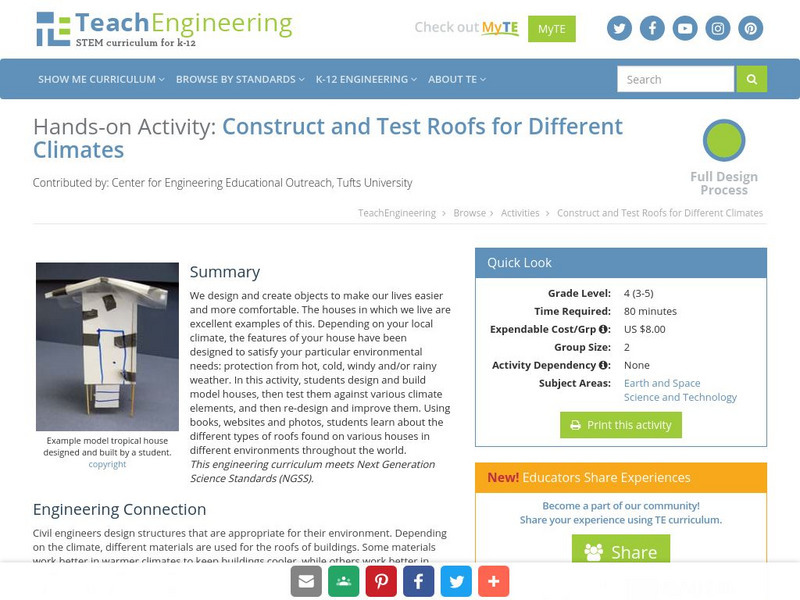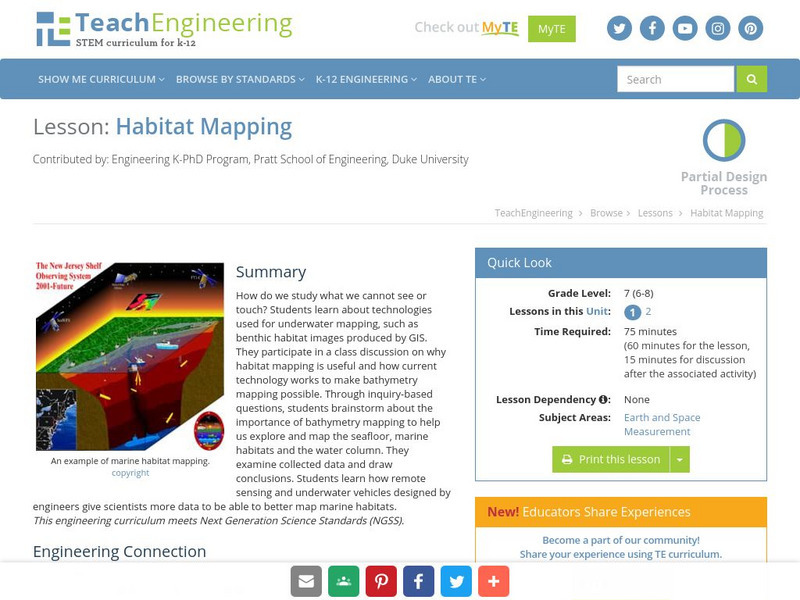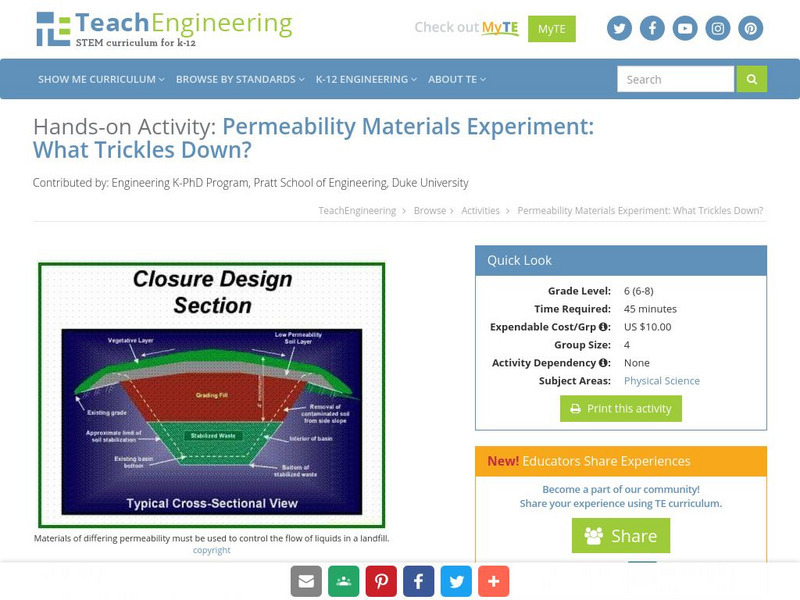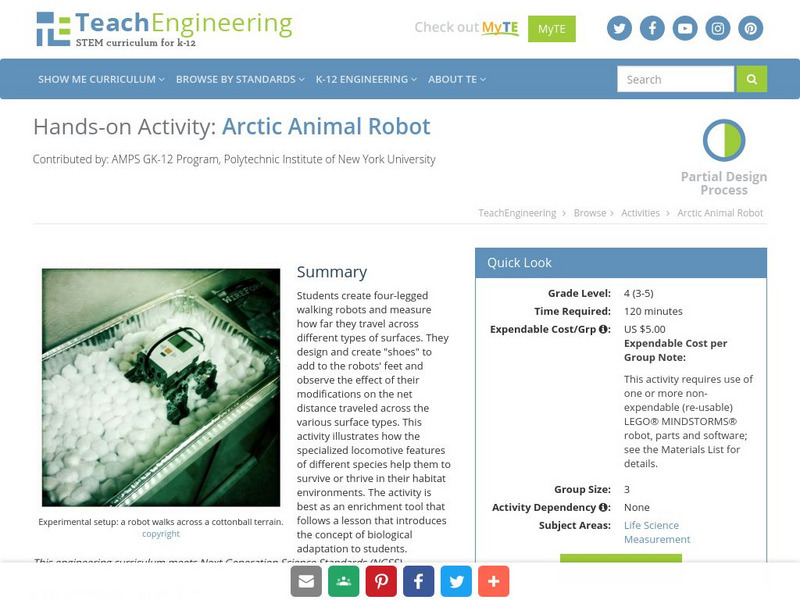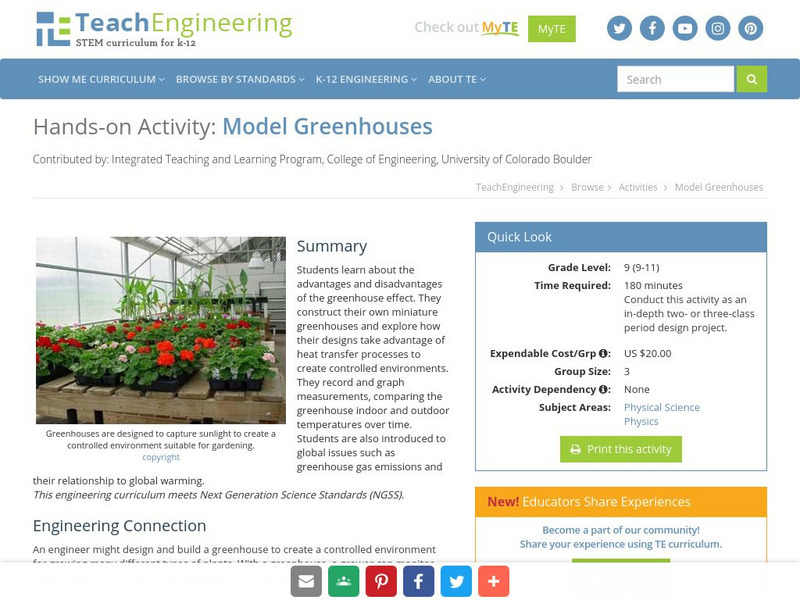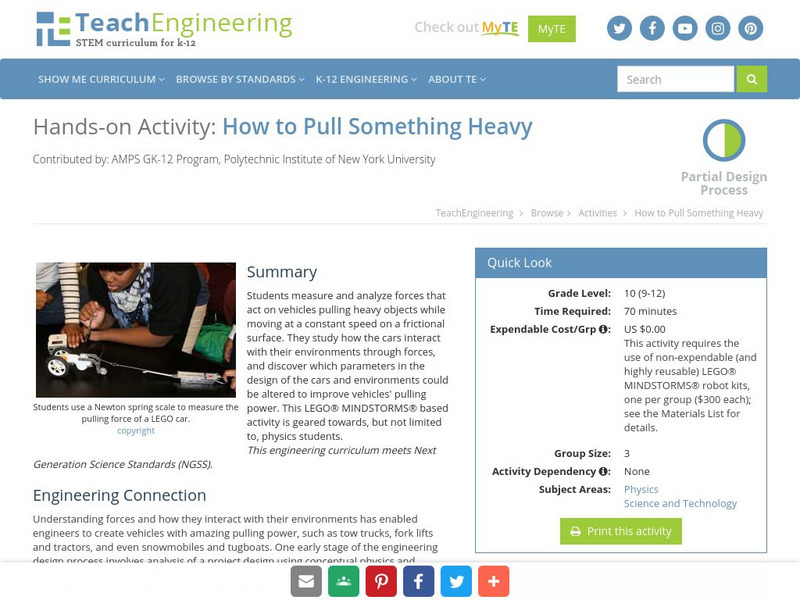TeachEngineering
Teach Engineering: The Other Water Cycle
For students that have already been introduced to the water cycle, this lesson is intended as a logical follow-up. Students will learn about human impacts on the water cycle that create a pathway for pollutants beginning with urban...
TeachEngineering
Teach Engineering: Materials Properties Make a Difference
Students investigate the materials properties-such as acoustical absorptivity, light reflectivity, thermal conductivity, hardness, and water resistancea-of various materials. They use sound, light and temperature sensors to collect data...
TeachEngineering
Teach Engineering: Construct and Test Roofs for Different Climates
We design and create objects to make our lives easier and more comfortable. The houses in which we live are an excellent example of this. Depending on your local climate, the features of your house will be different to satisfy your...
PBS
Kqed Quest: A Different Kind of Science and Nature Adventure
A multimedia offering for teachers and learners to explore the latest science, nature, and environment stories.
TeachEngineering
Teach Engineering: Habitat Mapping
The marine environment is unique and requires technologies that can use sound to gather information since there is little light underwater. In this lesson, the students will be shown benthic habitat images produced by GIS. These images...
Other
U.s. Green Building Council: Leadership in Energy & Environmental Design
LEED is a program for green building certification. Buildings are rated on a points system in one of five categories, including building design and construction, interior design and construction, building operations and maintenance,...
Massachusetts Institute of Technology
Mit: Open Course Ware: Chemicals in the Environment: Toxicology and Public Health
A college course featuring instructor's notes and case studies about the relationship between exposure to environmental chemicals and human diseases.
Science Buddies
Science Buddies: Career Profile: Environmental Engineering Technician
Read about the environmental engineering technicians who do the hands-on work that is developed by the environmental engineer. Science Buddies offers a career profile which outlines the educational requirements and lays out the nature of...
Other
Fuel Our Future Now: Gr. 6 8 Module: Designing a Vehicle for the Year 2020 [Pdf]
In this 6-8 teaching module, students learn about natural resources, human impact on the environment, and engineering design in vehicle transportation. Using real world scientific data and scientific reasoning skills, they investigate...
TryEngineering
Try Engineering: Ets1 1 :Toxic Popcorn Design Challenge
Young scholars learn about the engineering design process as they work in teams to design a process and a product to solve the Toxic Popcorn Challenge and save the city.
TeachEngineering
Teach Engineering: Sound Environment Shapers
In this lesson plan, students are introduced to the sound environment as an important aspect of a room or building. Several examples of acoustical engineering design for varied environments are presented to students. Students learn the...
TeachEngineering
Teach Engineering: Muscles, Muscles Everywhere
This activity helps students learn about the three different types of muscles and how outer space affects astronauts' muscles. They will discover how important it is for astronauts to get adequate exercise both on Earth and in outer...
TeachEngineering
Teach Engineering: Acid Rain Effects
Students conduct a simple experiment to model and explore the harmful effects of acid rain (vinegar) on living (green leaf and eggshell) and non-living (paper clip) objects.
TeachEngineering
Teach Engineering: Cool Views
In this activity, students will learn the meaning of preservation and conservation and identify themselves and others as preservationists or conservationists in relation to specific environmental issues. They will understand how an...
TeachEngineering
Teach Engineering: What Trickles Down?
Permeability is the degree to which water or other liquids are able to flow through a material. Different substances such as soil, gravel, sand, and asphalt have varying levels of permeability. In this activity, students will explore...
TeachEngineering
Teach Engineering: River Flow Rate
In this activity, students utilize their understanding and feel for flow rate from the Faucet Flow Rate activity to estimate the flow rate in a local river. The objective is for students to relate laboratory experiment results to the...
TeachEngineering
Teach Engineering: Sound
Students learn the connections between the science of sound waves and engineering design for sound environments. Through three lessons, students come to better understand sound waves, including how they change with distance, travel...
TeachEngineering
Teach Engineering: Form vs. Function
Students model and design the sound environment for a room. They analyze the sound performance of different materials that represent wallpaper, thick curtains, and sound-absorbing panels. Then, referring to the results of their analysis,...
TeachEngineering
Teach Engineering: Introduction to Environmental Engineering
Students are presented with examples of the types of problems that environmental engineers solve, specifically focusing on air and land quality issues. Air quality topics include air pollution sources, results of poor air quality...
TeachEngineering
Teach Engineering: Abdominal Cavity and Laparoscopic Surgery
For students interested in studying biomechanical engineering, especially in the field of surgery, this lesson serves as an anatomy and physiology primer of the abdominopelvic cavity. Students are introduced to the abdominopelvic...
TeachEngineering
Teach Engineering: Arctic Animal Robot
Students create four-legged walking robots and measure how far they travel across different types of surfaces. They design and create "shoes" to add to the robots' feet and observe the effect of their modifications on the net distance...
TeachEngineering
Teach Engineering: The Physics of Fluid Mechanics
Five lessons about the study of fluid mechanics. The unit concludes with students applying what they have learned to determine the stability of individual above-ground storage tanks given specific storm conditions so they can analyze...
TeachEngineering
Teach Engineering: Model Greenhouses
Students learn about the advantages and disadvantages of the greenhouse effect. They construct their own miniature greenhouses and explore how their designs take advantage of heat transfer processes to create controlled environments....
TeachEngineering
Teach Engineering: How to Pull Something Heavy
Students measure and analyze forces that act on vehicles pulling heavy objects while moving at a constant speed on a frictional surface. They study how the cars interact with their environments through forces, and discover which...


